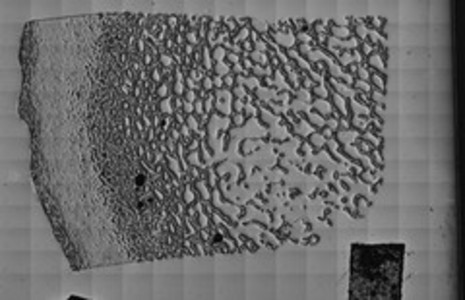What do antlers and human bones have in common?

Manganese is an element of interest in bone research due to its putative importance in healthy bone metabolism as well as in pathological conditions, possibly influencing fixation (or incorporation) of calcium into bones.
Since calcium is the main mineral constituent of bone tissue, the correlation of manganese with calcium elemental maps provides meaningful insight into the manganese distribution.
The particular meaning of manganese still not fully unraveled, however the information about manganese distribution in bone tissue may help revealing a novel mechanism leading to osteoporosis.
For this purpose, the results of measurements of osteoporotic and non-osteoporotic human bone samples will be presented for comparison.
In this case, one problem was the large amount of bone samples that was required in order to obtain statistically significant results. Therefor, in addition to human bones, the scientists also examined antlers of deer, that consists of bone substance. Deer cast their antlers every year, so they are are a suitable, easily accessible experimental model for the studies of bones.
For the analysis of bone samples Synchrotron Radiation induced confocal micro x-ray fluorescence analysis (SR-μXRF) technique was employed being the most powerful and sufficient instrument in detection and characterization of trace element distributions in bone tissue.
The measurements were performed at the FLUO beamline at ANKA, with support of the responsible beamline scientist R. Simon.
Characteristics of the confocal microXRF setup at FLUO were:
- Primary excitation: 9.2 keV
- Monochromator: W/Si multilayer
- Focusing optics: 2 polycapillary half-lenses (Pb-free at detector)
- Filter: 20 μm Al-foiul in front of the detector
- Detector: 50 mm2 Vortex
- Digital signal processor: Saturn XIA
- Beam size: 26 μm x 18 μm for antler samples; 27 μm x 18 μm for human bone samples
- Depth resolution; 33.6 μmTi-Ka for antler samples, 34.5 μm@Ti-Ka for human bone samples
The scanning resulted in elemental maps of manganese and calcium; the data were subsequently processed to gain the manganese to calcium countrate ratios, which allows to compare manganese spatial distribution in antlers and human bone samples and provides the material for further discussion and analysis.
[1] B. Pemmer et al., Bone, 57 (2013), 184-193
[2] T. Landete-Castillejos et al, (2012) Frontiers in bioscience (Elite edition), 4 Pages: 1385-90
[3] A. Turyanskaya et al., Spatially resolved manganese distribution in antler and human bone, (2015), X-ray Conference, Denver
